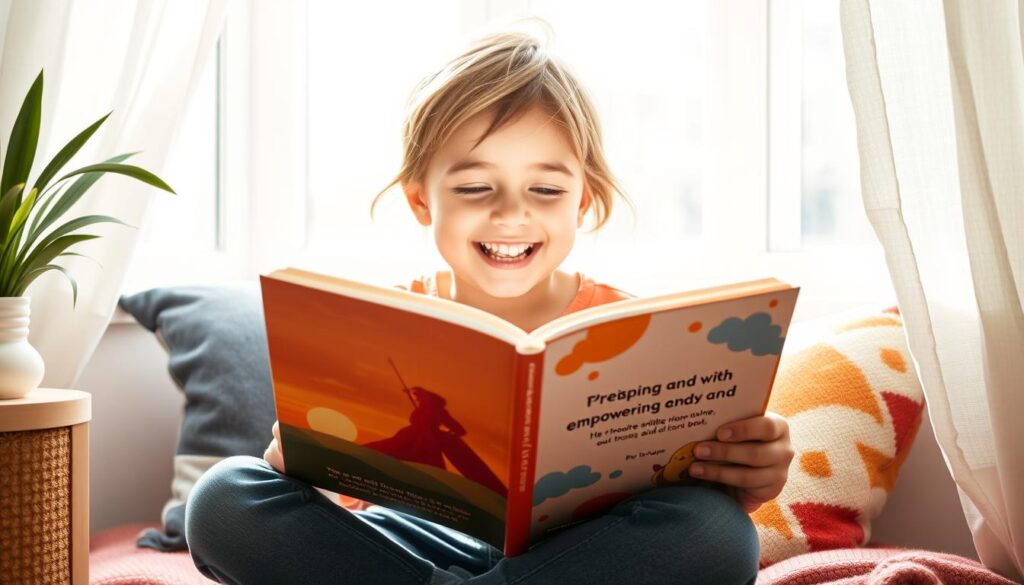What if the stories we read to our children before bed could shape their outlook on life and help them develop emotional resilience?
As a parent and educator, I’ve seen firsthand how the right bedtime story can transform a child’s night and gradually shape their approach to life’s challenges. These stories are more than just a way to help children fall asleep; they are a powerful tool for emotional and cognitive development.
By concluding with hope, solutions, and positive outcomes, these stories create a sense of security and optimism that extends beyond story time, nurturing young minds at their formative stages.
Why Bedtime Stories Matter
Reading bedtime stories to your child is a simple yet powerful way to enhance their sleep and emotional well-being. This nightly ritual offers a unique opportunity for bonding and relaxation.
Creating Special Bonding Moments
Bedtime stories create special moments between parents and children, fostering a sense of closeness and security. This bonding time is invaluable for a child’s emotional development. As you read together, you’re not just sharing a story; you’re building a lifelong connection.
Establishing Healthy Sleep Routines
A consistent bedtime story routine helps signal to your child’s brain that it’s time to sleep, making the transition smoother. Research supports the benefits of such routines, showing that children who follow consistent bedtime practices, including stories, typically fall asleep faster and experience fewer night wakings.
| Benefits of Bedtime Stories | Description |
|---|---|
| Creates Bonding Moments | Fosters closeness and security between parents and children |
| Establishes Sleep Routine | Helps signal to the child that it’s time to sleep, improving sleep quality |
| Reduces Bedtime Resistance | Makes bedtime a positive experience, reducing anxiety and resistance |
Understanding Positive Resolutions in Children’s Bedtime Stories

As a parent, I’ve come to realize the importance of positive resolutions in the stories I read to my children at bedtime. Positive resolutions in children’s stories can significantly influence their emotional and psychological development.
Defining Positive Resolutions
Positive resolutions in children’s bedtime stories refer to the conclusion of the narrative in a way that is uplifting, reassuring, and constructive. These resolutions help children feel secure and optimistic.
Contrast with Negative or Ambiguous Endings
Unlike negative or ambiguous endings, positive resolutions provide a clear and satisfying conclusion to the story. This clarity is essential for younger children who are still learning to navigate the world around them.
Here are some key points to consider about the impact of different types of story endings:
- Negative or ambiguous endings in stories can leave children feeling unsettled or anxious at bedtime, potentially affecting their sleep quality and emotional state.
- Stories without clear resolutions often prompt repeated questions from children as they try to make sense of unresolved narrative threads, which can delay sleep and create unnecessary worry.
- While some traditional fairy tales contain frightening elements or harsh consequences, modern adaptations often modify these aspects to provide more constructive messages while maintaining the story’s essence.
- Ambiguous endings may be appropriate for older children who can handle complexity, but younger children generally benefit from clearer resolutions that help them feel secure.
- Understanding the difference between thought-provoking complexity and unnecessarily disturbing content helps parents choose stories that challenge children appropriately without causing distress.
By choosing stories with positive resolutions, you can help your child develop a more optimistic outlook on life and improve their bedtime experience.
Emotional Benefits for Young Listeners
Bedtime stories with positive resolutions offer numerous emotional benefits for young listeners. These stories not only captivate children’s imagination but also provide them with a sense of security and comfort.
Building a Sense of Security
When children hear stories where challenges are overcome, it reinforces the idea that the world is a safe place. This sense of security is crucial for their emotional development, as it helps them feel protected and understood.
Reducing Bedtime Anxiety
Stories with positive resolutions can significantly reduce bedtime anxiety by reassuring children that problems have solutions. For instance, narratives where characters face and overcome fears similar to those experienced by the child can be particularly comforting. The calming effect of these stories comes from their ability to address worries indirectly, allowing children to process their concerns through the safe distance of fictional characters.

As a parent, reading such stories can be a powerful way to help your child relax and prepare for sleep. The combination of physical closeness with a trusted adult and emotionally satisfying story resolutions creates an ideal environment for anxiety reduction before sleep.
- Stories with positive resolutions help children feel secure and comforted.
- They reduce bedtime anxiety by showing that problems can be solved.
- The use of fictional characters helps children process their fears indirectly.
Cognitive Development Through Story Resolution
The resolution of stories is essential for fostering cognitive development in young minds. As children engage with stories, they begin to understand complex concepts and develop critical thinking skills.
Problem-Solving Skills
Stories with clear resolutions help children develop problem-solving skills by illustrating how characters overcome challenges. This narrative structure enables children to anticipate possible outcomes and make informed decisions.
Cause and Effect Understanding
Stories help children grasp the concept of cause and effect, showing how actions lead to consequences. This understanding is foundational for scientific thinking, historical understanding, and moral reasoning.
- Stories introduce sophisticated cause-and-effect relationships in accessible ways.
- Children learn to anticipate outcomes based on character choices and story events.
- This comprehension helps children make better choices in their own lives.
By engaging with stories that have positive resolutions, children develop essential cognitive skills that benefit them throughout their lives.
How Positive Resolutions Shape Worldview
Positive resolutions in children’s bedtime stories play a crucial role in shaping their worldview. As children listen to stories with uplifting endings, they begin to understand that challenges can be overcome and that good can prevail over adversity.
Instilling Optimism and Hope
Stories with positive resolutions instill optimism and hope in young minds. When children hear about characters overcoming obstacles, they learn to approach life’s challenges with a positive attitude.
Teaching Resilience Through Characters
Characters in stories who face setbacks but ultimately succeed provide powerful models of resilience. Children can internalize these lessons and apply them to their own challenges.
For children aged 7-12, stories often feature complex challenges and emotional journeys, helping them develop a nuanced understanding of resilience. By discussing how characters persevere, parents can help children make connections between story resilience and real-life situations.
| Benefits of Positive Resolutions | Description |
|---|---|
| Instilling Optimism | Stories with positive endings help children develop a positive outlook on life. |
| Teaching Resilience | Characters who overcome challenges teach children valuable lessons about perseverance. |
| Real-Life Applications | Parents can help children apply the lessons from stories to their own lives. |
For more famous bedtime stories that offer positive resolutions, you can explore resources like https://lunesia.app/famous-bedtime-stories/. These stories are great examples of how positive endings can shape a child’s worldview.
Age-Appropriate Story Selection

The right bedtime story can captivate your child’s imagination and help them develop essential life skills, but it’s essential to choose stories that fit their age group. As children grow, their ability to understand and relate to stories evolves, making age-appropriate story selection crucial.
Stories for Toddlers and Preschoolers (3-5 years)
For younger children, picture books are an excellent choice. These books often feature simple, clear positive resolutions that help establish a basic understanding of story structure and emotional satisfaction. When selecting picture books, look for ones with engaging illustrations and straightforward narratives.
Stories for School-Age Children (6-9 years)
School-age children are ready for more complex story arcs with multiple challenges before resolution. Stories where characters try several approaches before finding a successful resolution are particularly beneficial, as they build persistence and problem-solving flexibility. You can explore our collection of stories on Lunesia’s Children’s Stories page, which offers a range of engaging tales for this age group.
At this stage, children also benefit from stories that show characters making mistakes, learning from them, and then succeeding. These narratives help school-age children develop their sense of competence and learn from failure. Books that balance text and illustrations are ideal, as they bridge the transition from purely visual storytelling to more text-based narrative comprehension.
Classic Fairy Tales with Positive Resolutions
The world of fairy tales is rich with stories that not only captivate young minds but also offer positive resolutions to challenges, fostering resilience and hope. These timeless tales have been a cornerstone of childhood, providing valuable life lessons that extend beyond the pages of the book.

Cinderella and Overcoming Adversity
Cinderella is a quintessential fairy tale that teaches children about perseverance and the triumph of good over evil. Despite facing hardships, Cinderella’s story concludes on a hopeful note, showing that kindness and resilience can lead to a happy ending.
In fairytales picture books, Cinderella’s story is often vividly illustrated, making the narrative even more engaging for young readers.
The Ugly Duckling and Self-Acceptance
The Ugly Duckling, born different from his siblings, embarks on a journey of self-discovery. Through his transformation from an outcast to a beautiful swan, children learn about the importance of self-acceptance and the value of patience and hope.
- The Ugly Duckling’s transformation offers a profound message about identity and belonging.
- This story is particularly valuable for children who feel different, reassuring them that their uniqueness may be a special quality.
- The tale teaches patience and hope, showing that development takes time.
- Unlike many fairytales picture books that rely on external magic, The Ugly Duckling’s change comes naturally, emphasizing authentic growth.
- It provides an opportunity to discuss with children how we judge others or ourselves before understanding their true nature.
Modern Children’s Books with Empowering Endings
The world of children’s literature has evolved, offering a wide range of books with empowering endings that inspire young minds. Modern children’s books are designed to not only captivate young readers but also to impart valuable life lessons.

Picture Books for Younger Children
Picture books for younger children often feature simple, yet powerful stories that help them understand and navigate their emotions. These books use engaging illustrations and relatable characters to convey their messages.
Chapter Books for Independent Readers
Chapter books for independent readers aged 7-12 offer more complex resolution arcs that unfold over multiple chapters, helping children develop patience and longer attention spans. Successful chapter books often feature protagonists slightly older than the target reader, providing aspirational models of problem-solving and emotional resilience.
- Many modern chapter book series, such as “Diary of a Wimpy Kid” or “Dog Man,” use humor alongside positive resolutions, making the emotional lessons more accessible and enjoyable.
- Fantasy series for this age group often incorporate elements from fairy tales while creating more nuanced characters and resolutions that avoid simplistic good-versus-evil narratives.
- Chapter books that end each installment with a satisfying resolution while maintaining ongoing character development across a series help children experience both immediate satisfaction and longer narrative arcs.
Creating Your Own Stories with Positive Resolutions
Crafting bedtime stories with positive endings can be a fun and creative way to help your child develop emotional resilience. You can create personalized stories using tools like Lunesia’s personalized story generator.

Basic Story Structure Guidelines
Follow a simple narrative arc: introduce a character, present a challenge, and resolve it positively. This structure helps children understand cause and effect and builds problem-solving skills.
Personalizing Stories for Your Child
Incorporate elements from your child’s life, such as their friends, school experiences, or favorite activities, to make the story more relatable. Using their stuffed animals or toys as characters can also create immediate engagement.
By personalizing stories, you can help your child process daily experiences and challenges, making the resolutions more applicable to their own situations.
Addressing Difficult Topics Through Positive Resolutions
Bedtime stories can be a powerful tool in helping children address difficult topics and develop a positive outlook on life. By using stories with positive resolutions, you can help your child navigate various challenges.
Tackling Fears and Worries
Stories that address fears and worries can help children feel more secure and confident. These stories can provide a safe space for children to explore and understand their emotions.
Navigating Life Changes and Transitions
Stories about characters successfully navigating transitions, such as moving homes or changing schools, can help children envision positive outcomes for their own life changes. Effective transition stories acknowledge the full range of emotions involved, including sadness and anxiety, before showing adaptation and new happiness.
- Stories that show characters maintaining connections to their old world while building relationships in their new one provide models for healthy transition.
- Books about the first day in a new environment often show initial struggles followed by discoveries of unexpected pleasures or connections.

By using these stories, you can help your child develop the skills and confidence they need to tackle life’s challenges and thrive in a changing world.
The Role of Characters in Modeling Resolution
Characters in stories are not just figures in a narrative; they are mentors, friends, and guides. They help children understand complex emotions and situations, making the story more relatable and impactful.
The way characters interact with each other and resolve conflicts can teach children important life skills. By observing how characters handle difficulties, children can learn valuable lessons about problem-solving and resilience.
Heroes and Problem-Solvers
Characters who embody courage and determination inspire children to adopt similar traits. These heroes show that with perseverance and the right mindset, challenges can be overcome.
Supporting Characters and Teamwork
Supporting characters play a vital role in demonstrating the power of teamwork and friends. They show that having friends by your side can make a significant difference in overcoming obstacles.
Stories that feature characters working together towards a common goal highlight the importance of collaboration and mutual support. Characters who show unconditional love and acceptance provide models for healthy relationships.
| Character Trait | Lesson Learned | Example |
|---|---|---|
| Resilience | Perseverance in adversity | A character who keeps trying despite failures |
| Teamwork | Collaboration and mutual support | Characters working together to achieve a goal |
| Empathy | Understanding and supporting others | A character showing compassion to a friend in need |
For more insights on the art of storytelling, you can visit this resource.
Digital Resources for Positive Bedtime Stories
Parents can now leverage digital platforms to find bedtime stories with positive resolutions. This shift has opened up new avenues for storytelling, making it easier to engage children in narratives that foster emotional resilience and a positive worldview.

Apps and Websites for Parents
Several apps and websites offer a wide range of bedtime stories with positive endings. These platforms cater to different age groups and preferences, ensuring that parents can find suitable content for their children.
Audio Stories and Podcasts
Audio stories and podcasts provide a screen-free alternative for bedtime listening, allowing children to create their own mental images. Many children’s podcasts feature recurring characters, like adventurous cats, who face new challenges but always reach satisfying resolutions. I recommend audio stories for children sensitive to visual stimulation before sleep.
- Audio stories allow children to create their own mental images while enjoying narratives with positive resolutions.
- Many children’s podcasts feature episodic stories about recurring characters who face new challenges but always reach satisfying resolutions.
Incorporating Discussion After the Story
The discussion that follows a bedtime story is just as important as the story itself. It’s an opportunity to engage your child, reinforce the story’s message, and help them develop critical thinking skills.
Reflection Questions for Children
Asking your child questions about the story can help them reflect on what they’ve heard. Simple questions like “What was your favorite part?” or “How did the character feel?” can encourage them to think more deeply about the narrative.
Connecting Stories to Real Life
Helping your child connect the story to their own experiences can make the narrative more relatable and meaningful. You can say something like, “This reminds me of when…” to help them see the connection between the story and their own life in the real world.
- Discussing how the characters solved problems can help your child develop their own problem-solving skills.
- Reading books that address common childhood issues can provide a natural opportunity to discuss how the story’s resolution might apply to their own life.
- Gentle prompts can help your child recognize connections between the story and their experiences without feeling forced.
By incorporating discussion after the story, you can help your child get the most out of their bedtime reading experience.
Expert Recommendations for Storytelling Techniques
Crafting a compelling bedtime story involves more than just reading the words on the page. As a parent, you can elevate the experience with a few expert techniques.

Voice Modulation and Expression
Modulating your voice and using expression can bring characters to life. This helps your child engage more deeply with the story.
Creating the Right Environment
The physical environment for bedtime stories is crucial. I recommend a consistent, comfortable reading spot with minimal distractions. Soft lighting and a special “story basket” can create a soothing atmosphere, making storytime a special bonding experience.
- The physical environment for bedtime stories contributes significantly to how children receive and process the narrative and its resolution.
- I recommend establishing a consistent, comfortable reading spot with minimal distractions, helping children focus on the story and transition mentally to sleep time.
- Soft lighting that’s adequate for reading but signals it’s evening creates the right atmosphere for winding down with stories before sleep.
- Having a special “story basket” or shelf where bedtime books are kept creates a ritual around selecting the night’s story and helps children anticipate this special time.
- For children who have difficulty settling, incorporating gentle physical contact during storytelling—like a hand on their back or stroking their hair—pairs the positive resolution with physical comfort and security.
Cultural Diversity in Positive Resolution Stories

As we explore the world of children’s literature, we find that stories from different cultures offer a wealth of positive resolutions. I’ve observed that picture books featuring main characters of various ethnicities, family structures, abilities, and genders help children recognize that everyone deserves and can achieve positive outcomes.
Stories from Around the World
Stories featuring protagonists from diverse backgrounds help all children develop empathy while providing crucial representation for children who share those identities. For instance, books showing a girl or boy from a different cultural background solving problems in unique ways expand children’s understanding of the many valid approaches to challenges.
Celebrating Different Perspectives
Stories that present different perspectives on similar situations help children develop cognitive flexibility and recognize that there are multiple paths to positive outcomes. The growing diversity in children’s literature offers unprecedented opportunities to expose children to varied life experiences while reinforcing the universal human desire for positive resolution and emotional satisfaction. You can find more diverse stories for toddlers on https://lunesia.app/books-per-night-toddler/.
Conclusion: Nurturing Emotional Resilience Through Bedtime Stories
In the world of children’s literature, positive resolutions in bedtime stories are more than just happy endings; they’re tools for building resilience.
By incorporating positive resolutions, you help your child develop emotional strength and a positive outlook on life. The intimate context of reading together creates ideal conditions for absorbing these lessons.
Through thoughtful selection and discussion of stories, you provide your child with an invaluable emotional toolkit. This investment in bedtime stories yields returns far beyond literacy, contributing to their emotional health and relationship skills.
FAQ
What makes a bedtime story effective for my child?
An effective bedtime story has a positive resolution, engaging storyline, and relatable characters. It helps your child wind down and prepares them for a good night’s sleep.
How do I choose the right story for my child’s age?
For toddlers and preschoolers (3-5 years), simple stories with colorful pictures work best. For school-age children (6-9 years), you can opt for more complex stories with moral lessons.
Can I create my own bedtime stories for my child?
Yes, you can! Creating your own stories allows you to personalize them according to your child’s interests and needs. You can use basic story structure guidelines to craft a engaging tale.
How can I help my child relate to the story?
You can ask reflection questions after the story to help your child connect the narrative to their own life. This encourages critical thinking and emotional intelligence.
Are digital resources a good option for bedtime stories?
Yes, there are many apps, websites, and podcasts that offer a wide range of bedtime stories with positive resolutions. You can explore these options to find what works best for your child.
How can I make storytelling a special bonding experience?
You can create a cozy atmosphere, use voice modulation, and show enthusiasm while reading to make storytelling a special bonding experience for you and your child.
Can bedtime stories help my child develop emotional resilience?
Yes, bedtime stories with positive resolutions can help your child develop emotional resilience by teaching them about optimism, hope, and resilience through characters and storylines.




